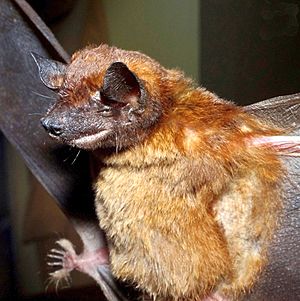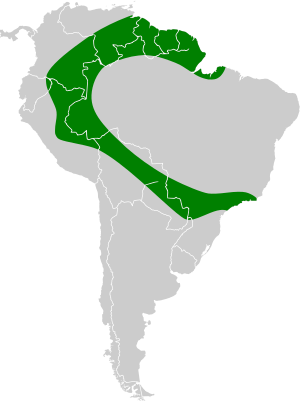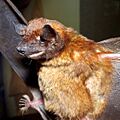Rufous dog-faced bat facts for kids
Quick facts for kids Rufous dog-faced bat |
|
|---|---|
 |
|
| Conservation status | |
| Scientific classification | |
| Genus: |
Molossops
|
| Species: |
neglectus
|
 |
|
| Synonyms | |
|
|
The rufous dog-faced bat (Molossops neglectus) is a special kind of bat that lives in South America. You can find these bats in countries like Argentina, Brazil, Colombia, Guyana, Peru, and Suriname. They are known for their unique face, which looks a bit like a dog's!
Contents
What is a Rufous Dog-faced Bat?
The rufous dog-faced bat is a small mammal that can fly. Like all bats, it has wings made of skin stretched between its long fingers and body. These bats are part of a group called "free-tailed bats." This means their tail sticks out a little bit from the edge of their tail membrane.
Why "Dog-faced"?
These bats get their name from the shape of their snout and face. Unlike some bats with very flat or pointy faces, the rufous dog-faced bat has a snout that looks a bit more like a dog's. This helps scientists tell them apart from other bat species.
Where Do Rufous Dog-faced Bats Live?
These bats live in several countries across South America. They are found in the northern and central parts of the continent. Their habitat often includes tropical forests and other warm, humid areas. They like places where they can find plenty of insects to eat and safe spots to rest during the day.
Their Home Range
Scientists have found these bats in different parts of the Amazon rainforest and nearby regions. They are good at living in various environments, but they usually prefer places with lots of trees and water.
What Do We Know About Them?
Not a lot is known about the daily lives of rufous dog-faced bats. Scientists are still studying them to learn more about their habits, what they eat, and how they raise their young.
Conservation Status
The rufous dog-faced bat is listed as "Data Deficient" (DD) by the International Union for Conservation of Nature (IUCN). This means that scientists don't have enough information to know if their populations are growing, shrinking, or staying the same. More research is needed to understand how many of these bats are out there and if they need special protection.
See also
- Murciélago cola libre para niños (Information about free-tailed bats for kids in Spanish)
Images for kids




